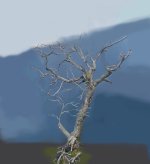GregoryGlitzer
Seedling
Hello everyone!
I absolutely need a second opinion about my apple tree, so I’ve joined the forum. I hope this thread is in the right section.
I have a fairly old apple tree that has been cared for in a pot for about 10 years.
What bothers me about this tree are the visible, very straight lines of the two trunks.
Do you have any ideas on what could be done with the tree?
I know the trunks are straight, but maybe you have an idea on how repositioning or a more radical measure could improve the tree.
I am looking forward to your ideas!
Thanks and best regards, Gregor
I absolutely need a second opinion about my apple tree, so I’ve joined the forum. I hope this thread is in the right section.
I have a fairly old apple tree that has been cared for in a pot for about 10 years.
What bothers me about this tree are the visible, very straight lines of the two trunks.
Do you have any ideas on what could be done with the tree?
I know the trunks are straight, but maybe you have an idea on how repositioning or a more radical measure could improve the tree.
I am looking forward to your ideas!
Thanks and best regards, Gregor










